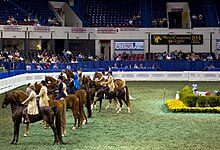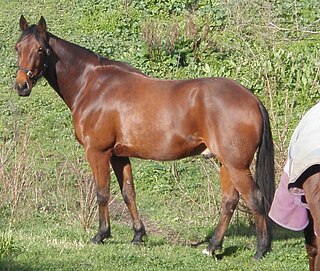
The Standardbred is an American horse breed best known for its ability in harness racing where they compete at either a trot or pace. Developed in North America, the Standardbred is recognized worldwide, and the breed can trace its bloodlines to 18th-century England. They are solid, well-built horses with good dispositions.
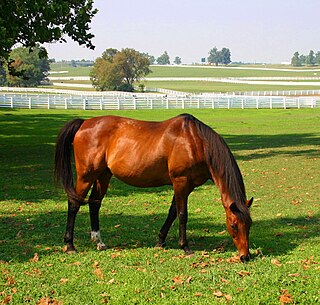
Kentucky Horse Park is a working horse farm, international equestrian competition venue, and an educational theme park opened in 1978 in Lexington, Kentucky. It is located off Kentucky State Highway 1973 and Interstate 75, at Exit 120, in northern Fayette County in the United States. The equestrian facility is a 1,224-acre (495 ha) park dedicated to "man's relationship with the horse." Open to the public, the park has a twice daily Horses of the World Show, showcasing both common and rare horses from around the globe. The horses are ridden in authentic costume. Each year the park is host to a number of special events and horse shows.

The Morgan horse is one of the earliest horse breeds developed in the United States. Tracing back to the foundation sire Figure, later named Justin Morgan after his best-known owner, as well as mares of the now-extinct Narragansett Pacer breed, Morgans served many roles in 19th-century American history, being used as coach horses and for harness racing, as general riding animals, and as cavalry horses during the American Civil War on both sides of the conflict. Morgans have influenced other major American breeds, including the American Quarter Horse, the American Saddlebred, the Tennessee Walking Horse, and the Standardbred.

The American Saddlebred is a horse breed from the United States. This breed is referred to as the "Horse America Made". Descended from riding-type horses bred at the time of the American Revolution, the American Saddlebred includes the Narragansett Pacer, Canadian Pacer, Morgan and Thoroughbred among its ancestors. Developed into its modern type in Kentucky, it was once known as the "Kentucky Saddler" and used extensively as an officer's mount in the American Civil War. In 1891, a breed registry was formed in the United States. Throughout the 20th century, the breed's popularity continued to grow in the United States, and exports began to South Africa and Great Britain. Since the formation of the US registry, almost 250,000 American Saddlebreds have been registered and can now be found around the world, with separate breed registries established in Great Britain, Australia, continental Europe, and southern Africa.

The Tennessee Walking Horse or Tennessee Walker is a breed of gaited horse known for its unique four-beat running-walk and flashy movement. It was originally developed as a riding horse on farms and plantations in the American South. It is a popular riding horse due to its calm disposition, smooth gaits and sure-footedness. The Tennessee Walking Horse is often seen in the show ring, but is also popular as a pleasure and trail riding horse using both English and Western equipment. Tennessee Walkers are also seen in movies, television, and other entertainment.
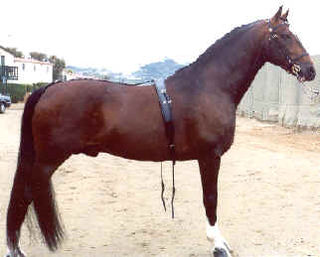
The Hackney is a recognized breed of horse that was developed in Great Britain. In recent decades, the breeding of the Hackney has been directed toward producing horses that are ideal for carriage driving. They are an elegant high stepping breed of carriage horse that is popular for showing in harness events. Hackneys possess good stamina, and are capable of trotting at high speed for extended periods of time.

The Narragansett Pacer was one of the first recorded horse breeds developed in the United States. It emerged in the 18th century (1700s), and was theorized to have been bred from a mix of English and Spanish breeds, although the exact cross is unknown. The Pacer was associated with, and bred in, the state of Rhode Island and the area of New England; as horse breeding shifted to Kentucky and Tennessee in the late 1700s, it became extinct by the 20th century.

The Hackney pony is a breed of pony closely related to the Hackney horse. Originally bred to pull carriages, they are used today primarily as show ponies. The breed does not have its own stud book, but shares one with the Hackney horse in all countries that have an official Hackney Stud Book Registry.
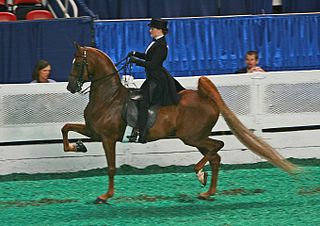
Saddle seat is a style of horse riding within the category of English riding that is designed to show off the high action of certain horse breeds. The style developed into its modern form in the United States, and is also seen in Canada and South Africa. To a much lesser extent, it is ridden with American horse breeds in Europe and Australia.
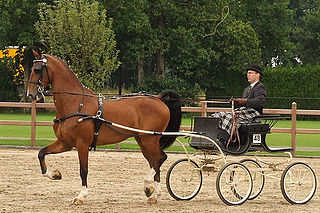
The Dutch Harness Horse, or Tuigpaard, is a warmblood breed of fine driving horse that has been developed in the Netherlands since the end of World War II. Their studbook is kept by the Koninklijk Warmbloed Paardenstamboek Nederland or KWPN. The breed is based on the native Groningen and Gelderland horses, which were formerly indispensable in agriculture and transportation services. Strict selection procedures and a clear breeding aim enabled breeders to produce a refined, high-stepping horse within a few decades. While with 40 sires and fewer than 2,000 broodmares the population is not large, Dutch Harness Horses are highly recognizable. In the past few years, a handful have come to North America, where they are used as sport horses and saddle seat horses alike.

Wing Commander (1943–1969) was an American Saddlebred show horse out of the mare Flirtation Walk and by the stallion Anacacho Shamrock. Wing Commander was a chestnut with four white socks and a thin white stripe that ran from his forehead all the way to his upper lip. He was trained to be a five-gaited horse, meaning he performed the walk, trot, canter, slow gait and rack. Through both sides of his pedigree, Wing Commander traced back to the highly influential Saddlebred stallions Rex McDonald and Bourbon King, who were themselves successful show horses. In 1948, the stallion won his first Five-Gaited World Grand Championship, a title he kept for a total of six years. In total he won 6 Five-Gaited World Grand Championships, and was the first of only two horses to accomplish this. In 1950 Life magazine featured Wing Commander as an example of a fine athlete and an American Idol. He was owned by Dodge Stables, and trained by Marvin Lane and ridden by Earl Teater. Wing Commander stood at stud at Castleton Farm in Lexington, Kentucky, and died at the age of 26.
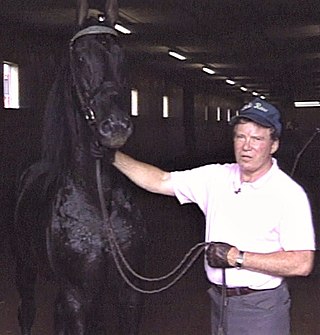
Belle Reve Farm is a horse farm located in Versailles, Kentucky that was owned by actor William Shatner, a breeder of American Saddlebred show horses.
Sky Watch was a five-gaited American Saddlebred show horse. He won four open World's Grand Championships and five stallion World's Grand Championships in the World's Championship Horse Show.
Bourbon King was an American Saddlebred stallion. He was known for being the founding sire of the popular Chief family of Saddlebreds.

Mary Gaylord McClean is an American horse breeder, horse owner and exhibitor, businesswoman and philanthropist. McClean owns and shows American Saddlebred horses and Hackney ponies, on which she has won multiple Championships. Many of her philanthropic ventures are horse-related.
Elisabeth Goth is a horse breeder, horse exhibitor, and businesswoman. She owns Elisabeth Goth, LLC in Kentucky and raises, shows and sells American Saddlebreds. She has won multiple awards and Championships in the horse industry. She is the vice president of the United States Equestrian Federation.
Redd Crabtree (1935–2015) was an American Saddlebred horse trainer. Crabtree, the son of notable Saddlebred trainers and saddle seat riding teachers Helen and Charles Crabtree, who owned Crabtree Stables, won three Five-Gaited World's Grand Championships and multiple World's Championships in the World's Championship Horse Show. He was president of the United Professional Horsemens Association, vice president and a director of the American Saddlebred Horse Association and was inducted into three Halls of Fame. Redd Crabtree died on January 19, 2015.

Breaking News is an American Saddlebred horse who won the Saddlebred Triple Crown in 2008, meaning he won the five-gaited stake in the Lexington Junior League Horse Show, the Five-Gaited World's Grand Championship in the World's Championship Horse Show, and the five-gaited stake in the American Royal Horse Show in the same year.
Boucheron was an American Saddlebred horse who won the Five-Gaited World's Grand Championship in 2004, the same year he won the five-gaited stake classes in the Lexington Junior League and American Royal Horse Shows, making him a Saddlebred Triple Crown winner.
Michele Macfarlane is an amateur horse trainer from the United States, who competes in the sport of saddle seat. She has been one of the leading amateur trainers and riders in the sport for over 40 years. Macfarlane resides in San Diego, California and is Marshal for the Scripps Miramar Ranch Saddlebreds parade unit.
